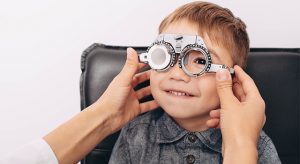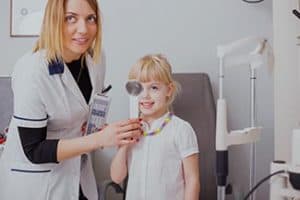Eye doctors report that over 4 in 10 of their contact lens patients are school aged.
According to the American Optometric Association (AOA), approximately 45 million people in the US wear contact lenses and 14.5 percent of all children under 17 years wear contact lenses. This age-based data is further broken down as follows:
- 2% are 9 years or younger
- 7% are 10-12 years
- 13% are 13-14 years
- 19% are 15-17 years
Which type of contact lenses are most appropriate for children?
Children under 12 years old are most frequently prescribed daily disposable soft contact lenses.
For children older than 12 years, reusable contact lenses can also be an option — these can be replaced every two weeks or monthly, depending on the type. However. single use and daily replacement contact lenses are prescribed mostly to avoid contamination issues that can arise from insufficient disinfection of contact lenses that are worn more than once.
Types of contact lenses
There are many different types of contact lenses to correct a variety of vision conditions:
- Soft Contacts: These lenses are most frequently prescribed for children as they are known to be comfortable and the easiest to adapt to. These lenses are available as daily, biweekly (every two weeks), and monthly disposables— extended wear options are also available.
- Rigid Gas Permeable Contacts (RGP): These lenses are also known as ‘hard lenses’, providing clear vision for many complex vision conditions. Their high oxygen permeability decreases the risk of eye infections. When starting to wear these lenses there may be a longer adjustment period than with soft lenses.
- Toric Lenses: Used for people with astigmatism, these lenses can be standard design for most common optical powers or specially customized if required.
- Bifocal/Multifocal Contacts: Used for children with focusing difficulties, or to prevent myopia progression, these lenses contain different lens powers for near and distant vision.
- Ortho-k Lenses: Used for children with myopia, these lenses are generally worn overnight, and work to reshape the cornea to enable clear vision during the daytime, without the need for eyewear. These lenses have also been shown to reduce the progression of myopia.
- Scleral Lenses: Used for patients with an irregular corneal shape, these lenses bridge over the cornea and rest on the white (sclera) of the eye.
When is a child ready for contact lenses?
Most optometrists feel that an optimal age to begin wearing contact lenses is between 10-12 years old.
If you are considering contact lenses for your child, first ask yourself:
- Does my child have good personal hygiene habits?
- Does my child handle responsibilities well?
If you answered yes to these two questions, then your child might be a great candidate for contact lenses!
Typically, a child’s motivation, as well as their maturity level, indicates whether a child is ready to wear contact lenses. Equally important, is the child’s ability to be responsible for contact lens care and the vital hygiene regimen involved.
In general, older children are typically highly motivated to wear contacts and usually adapt to them very quickly.
Other considerations are the child’s optical prescription, participation in sports and level of self-esteem.
What are the advantages and disadvantages of wearing contact lenses?
Advantages:
- Clear vision, without eyeglasses
- Lower risk of damaged or lost eyeglasses
- Enhanced feeling of ‘natural vision’, especially if the child has a high prescription
- Increased self-esteem
- Improved vision for sports:
- Reduced risk of eye injuries
- More stable vision
- Better peripheral vision
Disadvantages:
- Cleaning and disinfecting can be inconvenient
- Good eye-hand coordination is necessary for proper insertion/removal
- Increased risk of eye scratches and infections
- Lenses can fall out, get damaged, or lost during the day
- Blurred vision can result if lens moves too much
- Higher frequency of visits to the eye doctor
- Additional expenses
Schedule a contact lens fitting with an eye doctor near you.
SEE RELATED: Contact Lenses Safety for Children
Contact lenses and eye infections
Research indicates that most people (ranging from 40-90%) do not take proper precautions to maintain optimal contact lens hygiene.
Contact lens wearers must follow careful instructions to maintain optimal hygiene in order to prevent any eye infections.
Consider these statistics:
- Every year, 1 in 500 contact lens wearers contracts a serious vision threatening eye infection.
- Improper contact lens use can cause Keratitis—a painful eye infection that affects over 1 million people annually.
How to prevent an eye infection from contact lenses
While it may seem scary to think that wearing contact lenses can cause serious eye infections, keep in mind that you can minimize your risk of developing an infection by taking preventative measures:
- Always wash hands before inserting or removing contact lenses
- Keep fingernails short and clean
- Clean contact lenses and cases as directed by your eye doctor
- Replace contact lenses as directed by your doctor
- Attend all appointments with your eye doctor
Schedule an eye exam with an eye doctor near you and it is essential to keep up your appointments, even if you are not experiencing any problems with your contact lenses.
My child has astigmatism— are contact lenses an option?
Yes!
Astigmatism occurs when the cornea is irregularly shaped, causing a refractive error and blurry vision.
In recent years, many brands and styles of contact lenses, called toric lenses, have been designed for patients with astigmatism. Toric lenses are now available as daily, biweekly, and monthly replacement options.
Multifocal contact lenses that contain lens powers for astigmatism and near vision problems are also on the market, as well as lenses designed for overnight wear. There are also special order toric lenses that can virtually correct any amount of astigmatism!
A closer look at toric contact lenses for astigmatism
1) Soft contact lenses are lenses that are the most commonly prescribed contact lenses for children with astigmatism. Once placed on the eye, these lenses are designed to rotate on the child’s eye to ensure they fit properly on the irregularly shaped cornea for proper alignment of lens powers.
2) Rigid Gas Permeable (RGP) contact lenses can correct astigmatism due to their rigid design. These contact lenses maintain their spherical shape, instead of conforming to the irregular shape of the cornea. The front surface of the RGP contact lens actually takes over the job of the cornea by refracting light for clear vision.
3) Scleral lenses are large-diameter RGP contacts that enable correction of highly irregular astigmatism. These lenses sit above the cornea and rest on the sclera, the white, part of your eyes.
4) Hybrid contact lenses are made of a rigid gas permeable lens material in the center, with a softer material on the outer part of the lens. Hybrid contact lenses can be an optimal choice because they provide the sharp vision of RGP lenses and the comfort of toric soft lenses.
Many children, especially into their teen years, express their desire to wear contact lenses and contact lenses can be beneficial for children for a variety of reasons, including convenience, appearance, sport and myopia progression.
LEARN MORE: Guide to Children’s Eye Exams
If you think your child may be ready for contact lenses, schedule an appointment with your eye doctor to discuss your child’s individual needs.
Your doctor will take the time to advise if your child is ready, which type of contact lens is most suitable for their individual needs, and provide all the training required to ensure your child enjoys the many benefits that contact lenses can offer.









